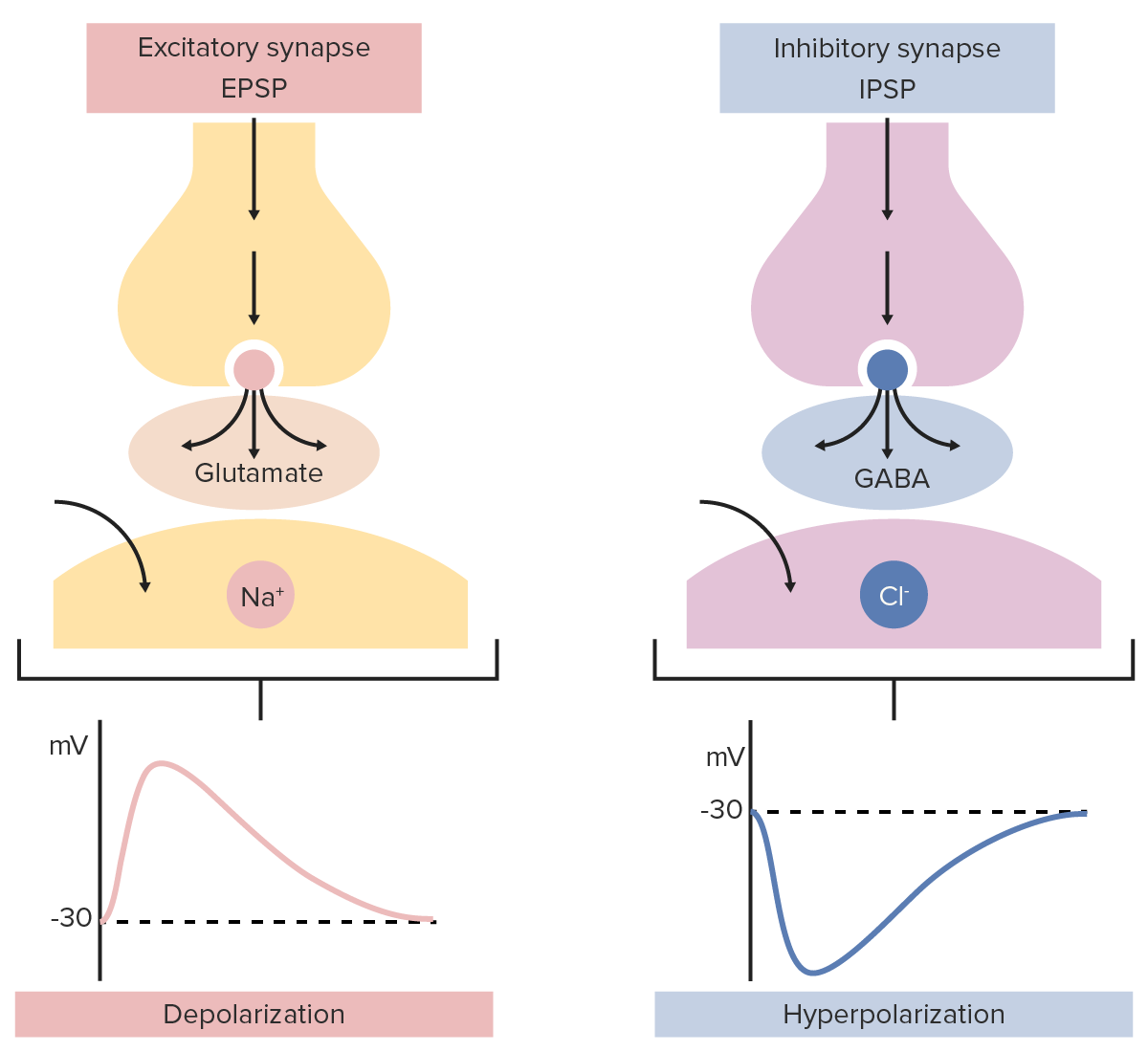Biology A-level Topic 8: Grey Matter
0.0(0)
0.0(0)
New
Card Sorting
1/245
Earn XP
Description and Tags
Study Analytics
Name | Mastery | Learn | Test | Matching | Spaced |
|---|
No study sessions yet.
246 Terms
1
New cards
What are the two regions of the human nervous system?
**Central Nervous System** (CNS) and the **Peripheral Nervous System** (PNS)
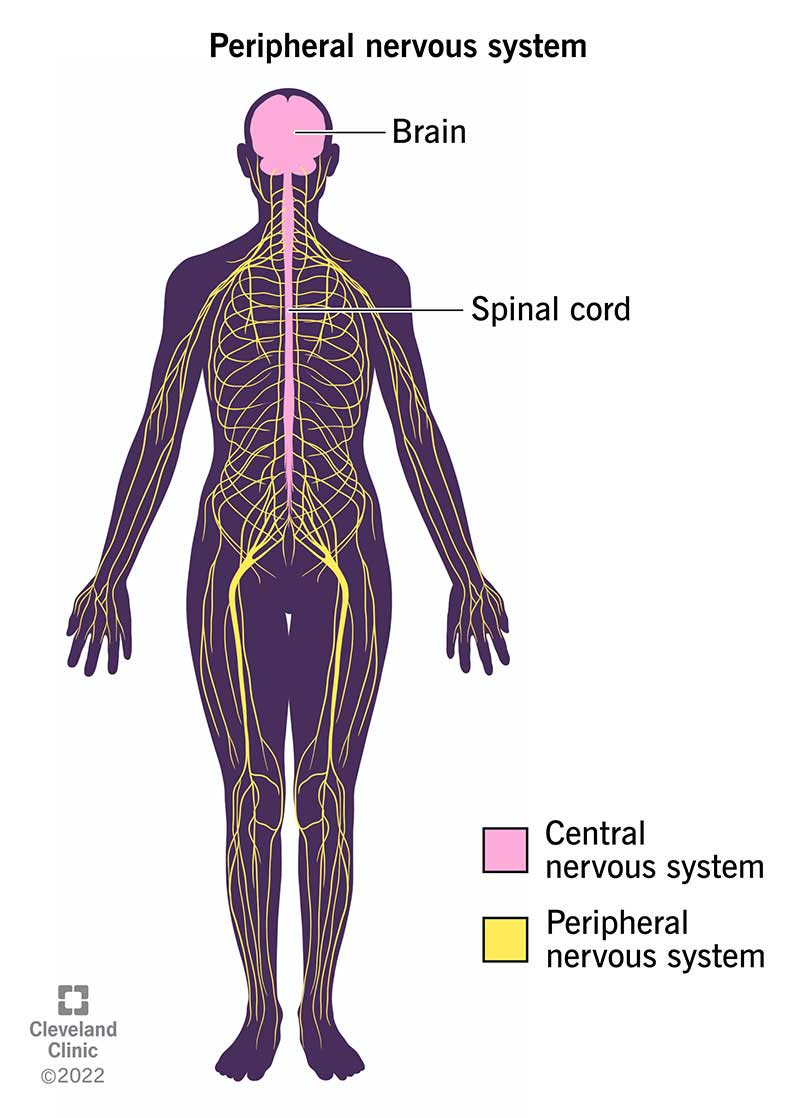
2
New cards
What are the two regions made up of?
==CNS==
*consists of brain and spinal cord*
* relay neurones
* intermediate neurones
==PNS==
* motor neurones
* sensory neurones
*consists of brain and spinal cord*
* relay neurones
* intermediate neurones
==PNS==
* motor neurones
* sensory neurones
3
New cards
What does the CNS and PNS do (briefly)?
__PNS__
* **provides** sensory **info** to the CNS
__CNS__
* **process info** and acts as **command centre**
* **provides** sensory **info** to the CNS
__CNS__
* **process info** and acts as **command centre**
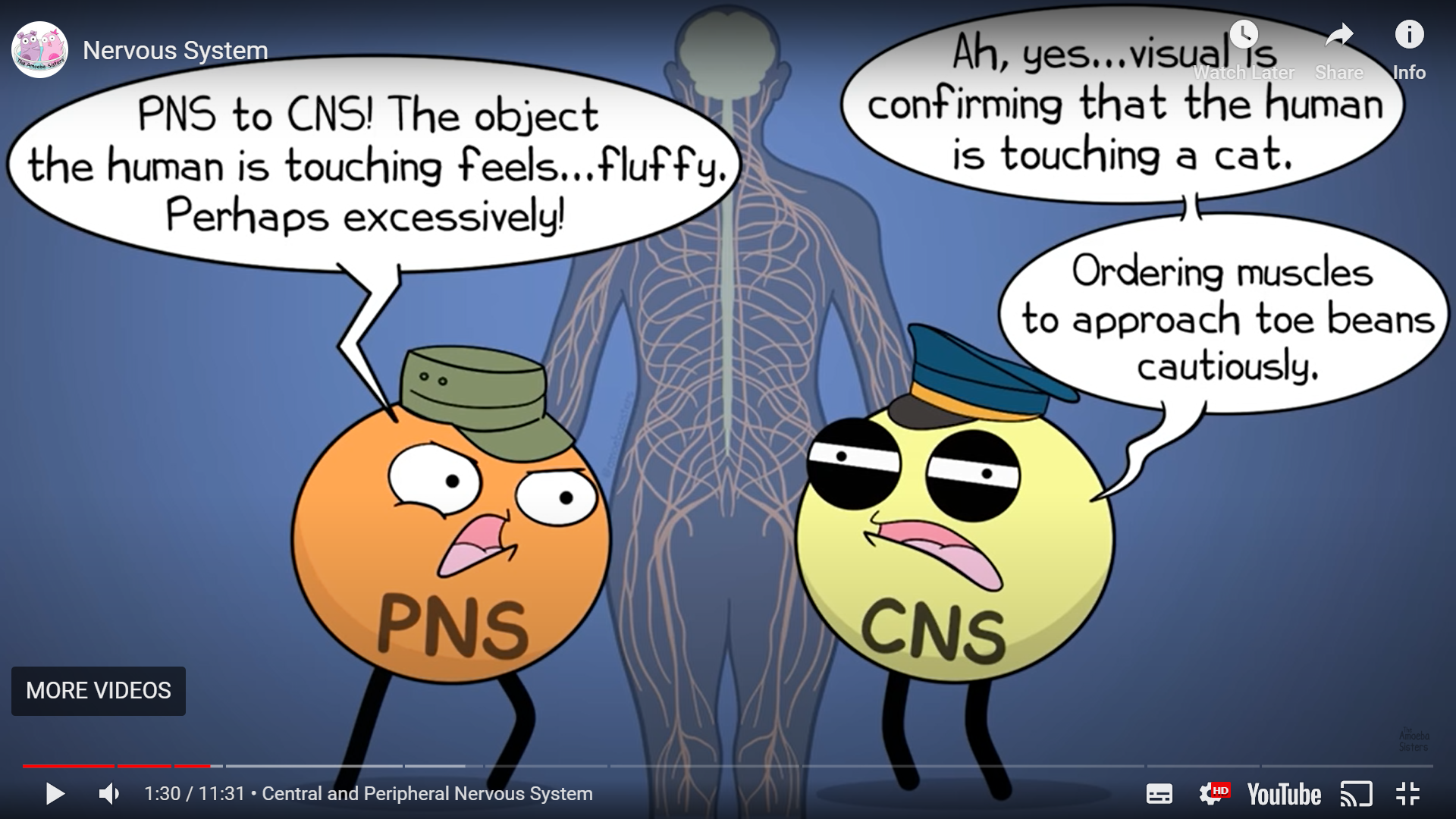
4
New cards
Feature of the CNS
The neurones its made up of **only have connections with other neurones**. (not receptors/effectors)
5
New cards
Feature of the PNS
* the neurones its made up from **connect the CNS to receptors and effectors.**
6
New cards
what are the three types of neurone?
sensory, relay, motor
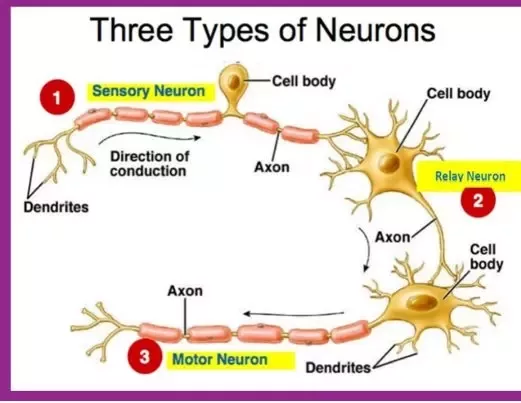
7
New cards
compare the structures of each type of neurone
__**Sensory**__
* myelinated dendron
* short axon
* cell body in middle
__**Motor**__
* myelinated dendron
* long axon
* cell body at the top
__**Relay**__
* not myelinated (short and found in cns so not needed)
* more dendrites
* small cell body
* myelinated dendron
* short axon
* cell body in middle
__**Motor**__
* myelinated dendron
* long axon
* cell body at the top
__**Relay**__
* not myelinated (short and found in cns so not needed)
* more dendrites
* small cell body
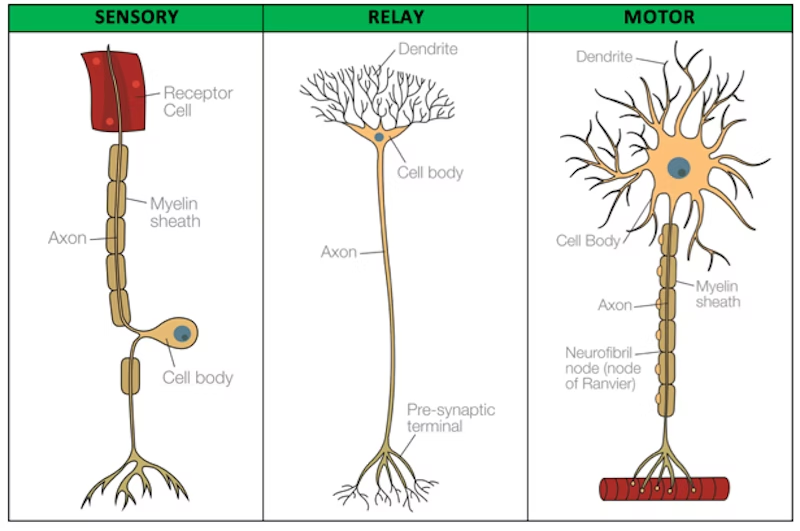
8
New cards
what is a ==sensory neurone==?
transmit information from the **receptors to the CNS**
*(I’ve touched something lemme tell the brain)*
\
* its myelinated therefor fast conducting.
*(I’ve touched something lemme tell the brain)*
\
* its myelinated therefor fast conducting.
9
New cards
what is a ==relay neurone==?
transmits **electrical impulse from sensory to motor**
10
New cards
what is a ==motor neurone==?
transmit information from the **CNS to effectors**
*(I, the brain, has got the info lemme tell my body to react)*
*(I, the brain, has got the info lemme tell my body to react)*
11
New cards
Motor neurone in the somatic (voluntary)
neurones are **fast conducting** - supplying **skeletal muscles**
12
New cards
Motor neurone in the autonomic (non-voluntary)
neurones are **slow conducting** - supply **smooth muscle** in the **organs, cardiac muscle**.
13
New cards
what two systems consist of the Peripheral nervous system?
**Somatic Nervous System** and the **Autonomic Nervous System**
14
New cards
What is the role of the ==somatic nervous system==?
**contact effectors** (they mostly **contact** the **skeletal muscles)** and is concerned with the **conscious/voluntary activity**
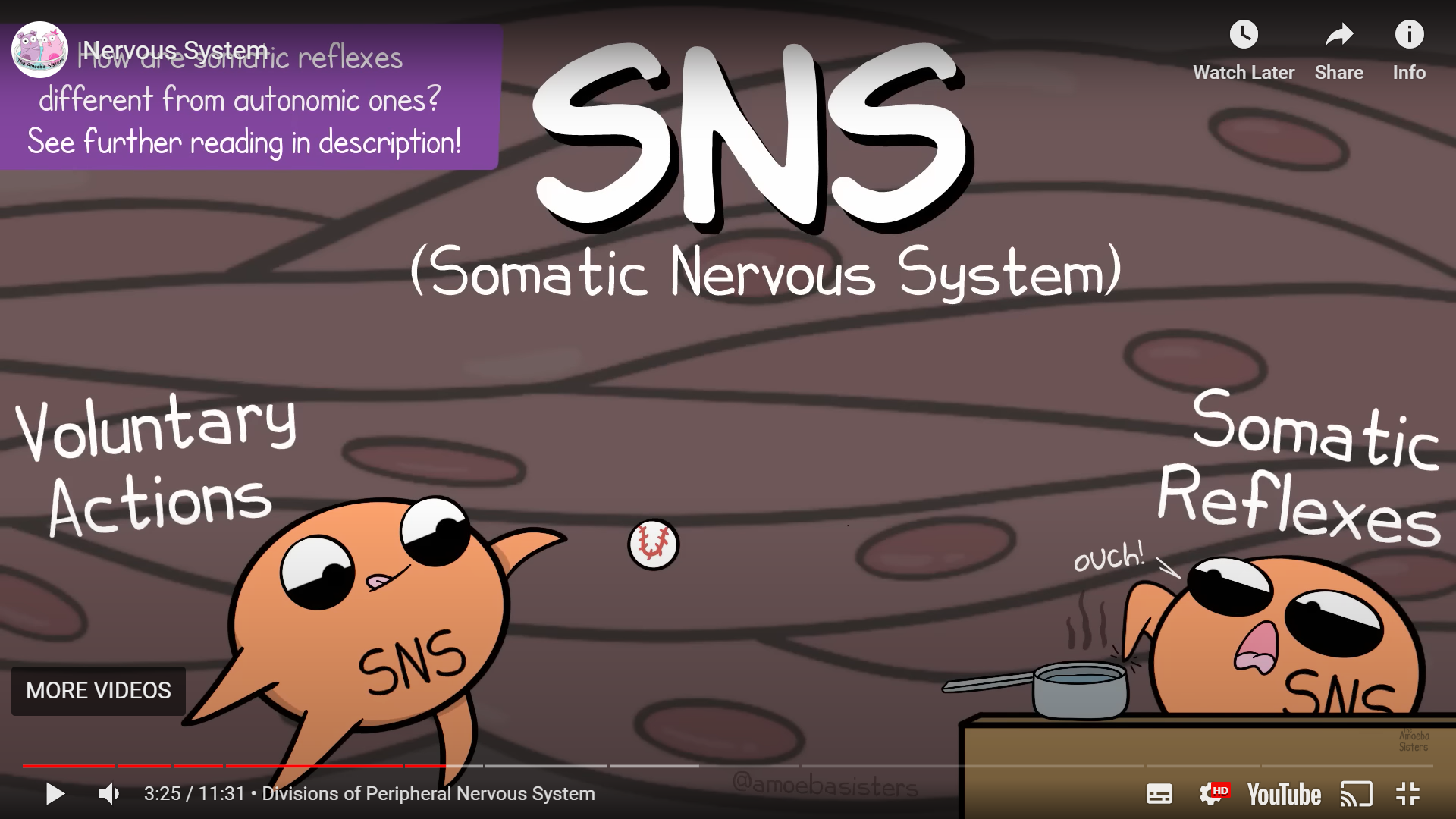
15
New cards
what is the role of the ==autonomic nervous system==
**controls unconscious activities** including **heart rate, smooth muscle and digestive system** *(internal)*
\
*(i’m guessing how your internal body reacts to certain things, like if you scared obvs your heart rate will increase)*
\
*(i’m guessing how your internal body reacts to certain things, like if you scared obvs your heart rate will increase)*
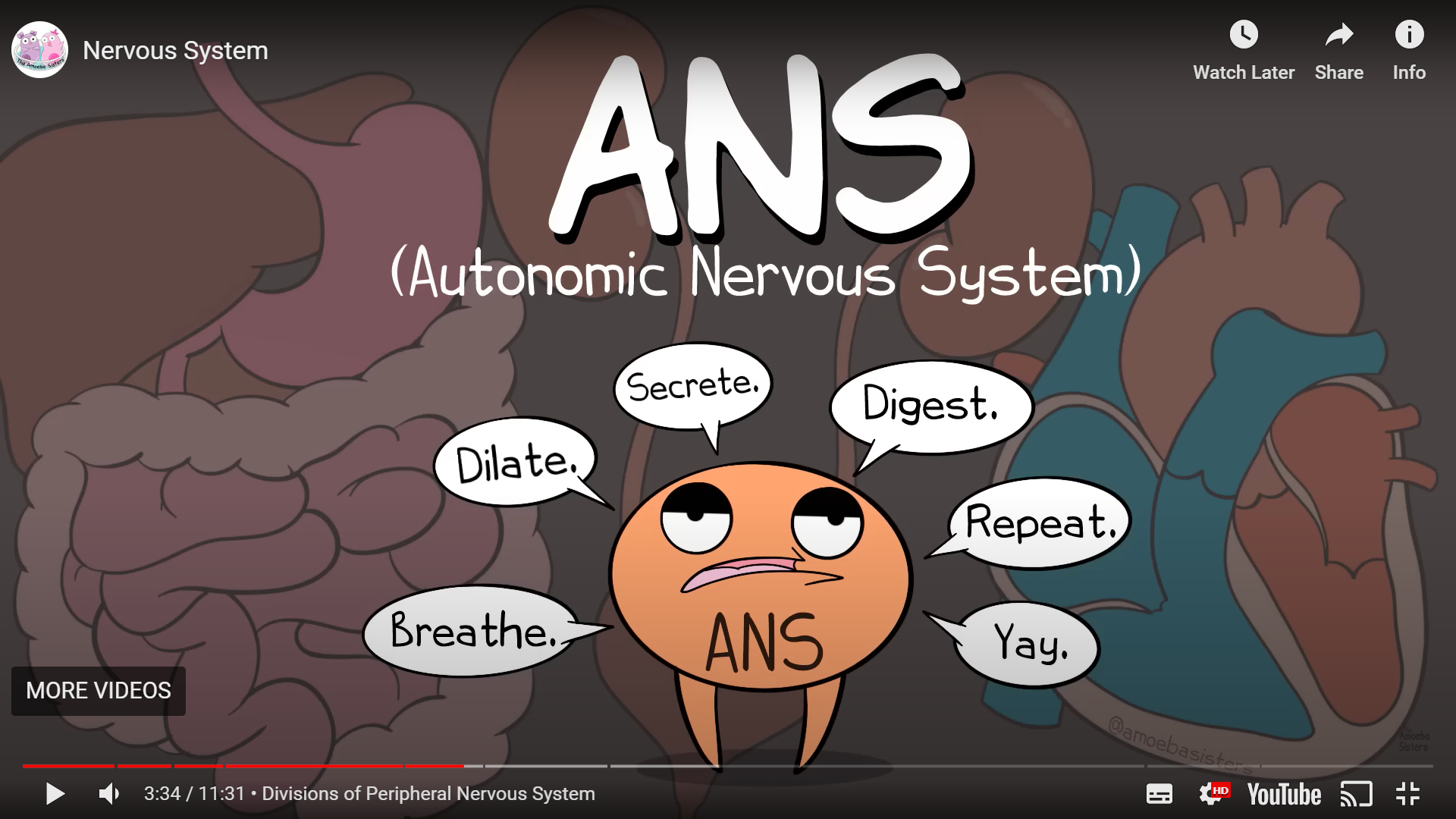
16
New cards
what two other systems can autonomic nervous system be divided into?
**Sympathetic** and **Parasympathetic**
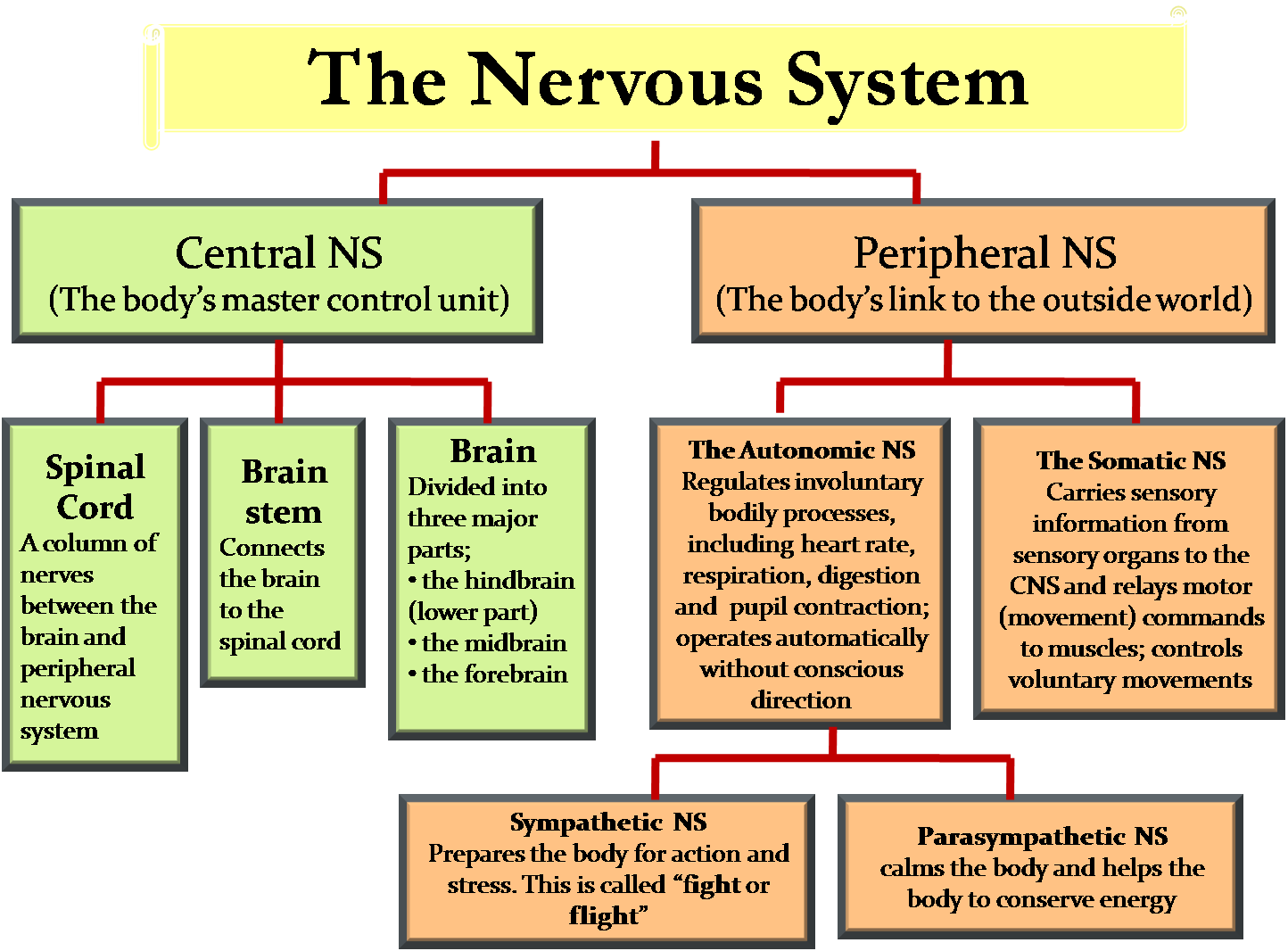
17
New cards
what is ==sympathetic==?
**preps body for activity**
known as the **fight or flight response** (*speeds up heart rate, stops digestive system like its prepping you*)
\
(idk but think like sims, they always/chaotic on the move)
known as the **fight or flight response** (*speeds up heart rate, stops digestive system like its prepping you*)
\
(idk but think like sims, they always/chaotic on the move)
18
New cards
what is ==parasympathetic==?
preps body for **rest and digest, conserves energy**
you can start to **relax** now and continue with your bodily functions
you can start to **relax** now and continue with your bodily functions
19
New cards
what is antagonistic and how does it link to sympathetic and parasympathetic?
*one contracts the other relaxes*
as we are in sympathetic mode, parasympathetic mode is ditched
(cause if I were to see nanno walking into class i most definitely wont be relaxing and unbothered lmao)
as we are in sympathetic mode, parasympathetic mode is ditched
(cause if I were to see nanno walking into class i most definitely wont be relaxing and unbothered lmao)
20
New cards
what is the function of a neurone/nerve cells?
**carry** **electrical signals** in the nervous system.
21
New cards
what is a ==neurone==?
a **single** cell
22
New cards
what is a ==nerve cell==?
more **complex structure** containing a **bundle of the axons** **of many neurones** surrounded by a protective covering
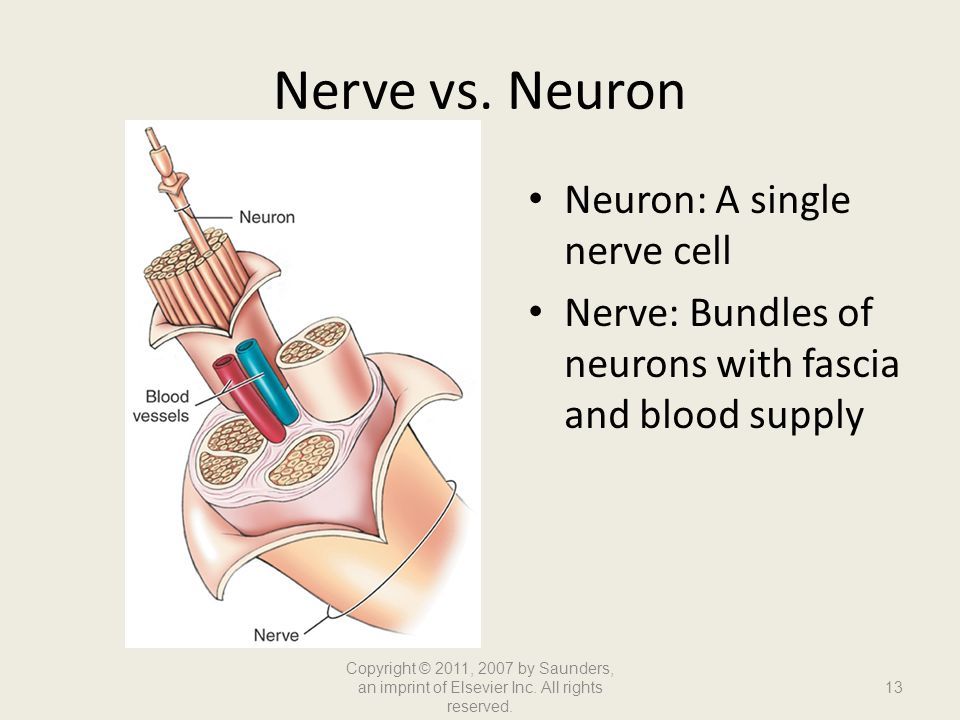
23
New cards
what are the three main parts of a neurone?
* Cell Body
* Dendrites
* The Axon
* Dendrites
* The Axon
24
New cards
What is the ==Cell Body?==
__Structure__
1. contains **nucleus** and **other organelles** (eg. mitochondria)
\
__Function__
1. **carries out** all normal **functions of the cell** (ATP, protein synthesis etc)
2. ATP is needed for **active transport of ions in and out of the cell** in an **impulse**.
1. contains **nucleus** and **other organelles** (eg. mitochondria)
\
__Function__
1. **carries out** all normal **functions of the cell** (ATP, protein synthesis etc)
2. ATP is needed for **active transport of ions in and out of the cell** in an **impulse**.
25
New cards
What is the ==Dendrite==?
__Structure__
1. **branches** of the neurone membrane
__Function__
1. **receives signals** from **other** neurones
1. **branches** of the neurone membrane
__Function__
1. **receives signals** from **other** neurones
26
New cards
What is the ==Axon==?
__Structure__
1. **single , long thin extension**
2. **vary** in length
3. surrounded by **lipid layer** (Myelin Sheath)
__Function__
1. carries **electrical signals away** from the **cell body** towards **synapse.**
\
1. **single , long thin extension**
2. **vary** in length
3. surrounded by **lipid layer** (Myelin Sheath)
__Function__
1. carries **electrical signals away** from the **cell body** towards **synapse.**
\
27
New cards
Name all the structures of a neurone (8)
* cell body
* nucleus
* dendrites
* axon
* myelin sheath
* schwann cell
* node of ranvier
* axon terminal
\
* nucleus
* dendrites
* axon
* myelin sheath
* schwann cell
* node of ranvier
* axon terminal
\
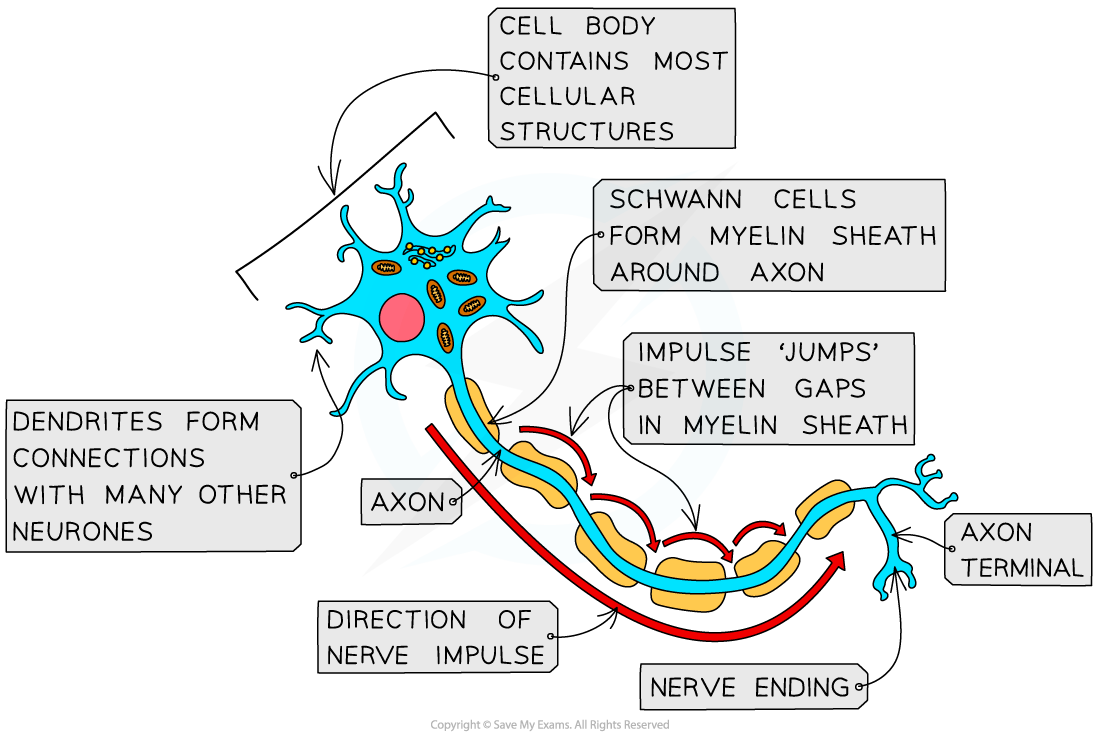
28
New cards
what is the role of the myelin sheath and what is it produced by?
what is it also surrounded by?
what is it also surrounded by?
* acts as an **electrical insulator** which **speeds rate** of electrical impulse.
**produced/surrounded by schwann cells** (layer of fatty substance-increases speed of impulse)
\
*surrounded by protein/lipid covering*
**produced/surrounded by schwann cells** (layer of fatty substance-increases speed of impulse)
\
*surrounded by protein/lipid covering*
29
New cards
what exactly is the definition of ==myelination==
a layer of **fatty substance** formed from **Schwann cells** wrapped **around** the **neurone**.
30
New cards
what is the ==synapse==?
**gap** between **neurones**
31
New cards
what is the ==reflex arc==?
an **unconscious, involuntary response** to a **stimulus.**
* performed by **components of** the **peripheral nervous system**
* after **action has been performed** **info** is **sent to the brain** so person **becomes aware** what just happened.
* performed by **components of** the **peripheral nervous system**
* after **action has been performed** **info** is **sent to the brain** so person **becomes aware** what just happened.
32
New cards
what are two examples of reflex arc?
* pupil reflex
* withdrawal reflex - body **withdraws away from a pain**ful stimulus.
\
(*the pathway taken by nerve impulses or electrical signals to carry out these responses is called a reflex arc.*)
* withdrawal reflex - body **withdraws away from a pain**ful stimulus.
\
(*the pathway taken by nerve impulses or electrical signals to carry out these responses is called a reflex arc.*)
33
New cards
what is a ==stimulus==?
any **change in the external environment** (touching fire/a sharp knife etc)
34
New cards
give two benefits of the reflex action
* very quick and **rapid response** which **protects body from harm** (survival)
* does not have to be learnt, **effective from birth** (bebe grabbing your finger)
* does not have to be learnt, **effective from birth** (bebe grabbing your finger)
35
New cards
give two reasons why the reflex response is quick
* signals **do not need to go the the brain** and back (doesn’t go to brain hence why its ‘unconscious’)
* does **not involve many synapse**, normally slow down to transmit across neurones
* does **not involve many synapse**, normally slow down to transmit across neurones
36
New cards
what components are included in the reflex arc? (5)
* receptor
* sensory neurone
* relay neurone
* motor neurone
* effector organ
* sensory neurone
* relay neurone
* motor neurone
* effector organ
37
New cards
explain in order the reflex arc (5)
1. **Receptor** detects **stimulus**, generates **nerve impulse**
2. **Sensory neurone** carries **nerve impulse** to the **CNS** (Spinal Chord) along sensory pathway
3. Sensory neurone **synapse with relay neurone**
4. Relay neurone **synapse with motor neruone** and **leaves spinal chord**
5. Motor neurone **carries** **impulse producing a response** as it carries to **effector organ**
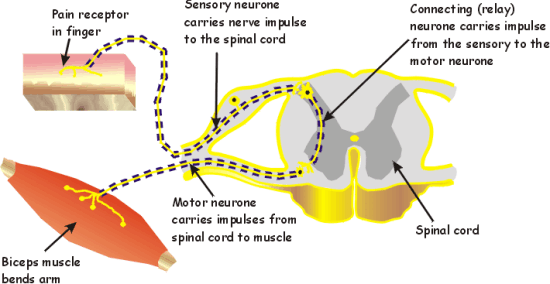
38
New cards
Role of the ==Receptor==
* **detects stimulus** and physical change
* turns this **into** an **electrical signal**
\
*eg. pain receptors, thermoreceptors, mechanoreceptors, chemoreceptors*
* turns this **into** an **electrical signal**
\
*eg. pain receptors, thermoreceptors, mechanoreceptors, chemoreceptors*
39
New cards
Role of the ==Sensory neuron==
carries nerve impulse/electrical **signal to the CNS**
40
New cards
Role of the ==Relay/Intermediate neurone==
**receive info** from sensory, **process this quick** and decides **response** (should i move my hand or not)
41
New cards
Role of the ==Motor neurone==
carries **nerve impulse to the effector** organ
* *they have a* ***single large axon***
* *they have a* ***single large axon***
42
New cards
Role of ==Effector organ==
acts in **response to the stimulus**
* *almost always a* ***muscle fibre*** *or a* ***group of muscle fibre***
* *almost always a* ***muscle fibre*** *or a* ***group of muscle fibre***
43
New cards
What is the amount of light entering our eyes controlled by?
the **reflex action**
44
New cards
In light change, what controls the size of the pupil?
**Muscles** of the **Iris**
45
New cards
What are the Iris muscles called?
**Circular**
**Radial**
**Radial**
46
New cards
Circular and Radial muscles are ==antagonistic==, what does this mean?
As **one contracts,** the **other relaxes**
47
New cards
What nervous system are the radial and circular muscles controlled by?
**autonomic** (unconscious, the body does it itself)
48
New cards
What type of autonomic reflex is the radial muscles controlled by?
**sympathetic** (fight or flight, pulls eye open to see in case there is anything spooky!)
49
New cards
What type of autonomic reflex is the circular muscles controlled by?
**parasympathetic** (we always usually in the light so your eye is ‘relaxed’ here)
50
New cards
What happens to the eye when a person is in dim/dark light?
pupil **dilates** *(expand*) to **allow more light to enter the eye**, any light is can get, so we can see a bit clearer.
51
New cards
What do Radial and Circular muscles do in dark light?
* **Radial muscles contract** - ‘**pulling**’ pupil **open** to allow **more light**
* **Circular muscles** are **relaxed** as its not their time to shine
* **Circular muscles** are **relaxed** as its not their time to shine
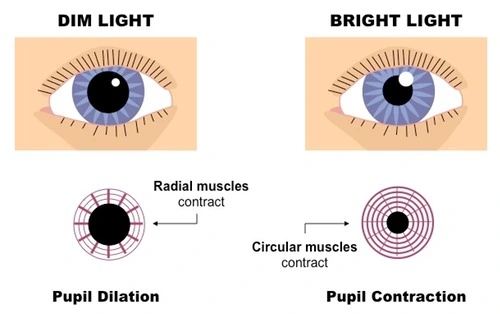
52
New cards
What happens to the eye when a person is in white/bright light?
pupil **constricts** (*squeeze*) to **allow less light to enter the eye**, **protecting** receptors and **retina from damage**
53
New cards
What do Radial and Circular muscles do in bright light?
* **Radial Muscles relax** as its not their time to shine
* **Circular muscles contract** - ‘**squeezing**’ pupil to **allow less light** in (smaller hole of light coming through eye)
* **Circular muscles contract** - ‘**squeezing**’ pupil to **allow less light** in (smaller hole of light coming through eye)
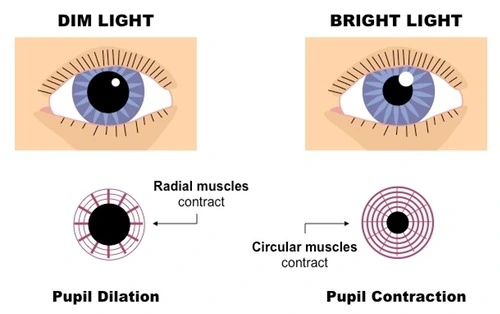
54
New cards
What is ==Resting Potential==?
state of nerve fibres when they are **not conducting/transmitting an impulse**
55
New cards
What is the resting potential of a neurone?
**-70mV**
56
New cards
What is the definition of ==potential difference==?
**Difference of electrical charge/potential between two points**. In this case **inside and outside the axon** of a neurone.
57
New cards
What do we mean when we say a neurone has a negative resting potential?
**Inside** of the neuron is **negatively charged** **compared to** the **outside** of the neurone (outside and inside of axon)
\
*due to uneven distribution of charges*
\
*due to uneven distribution of charges*
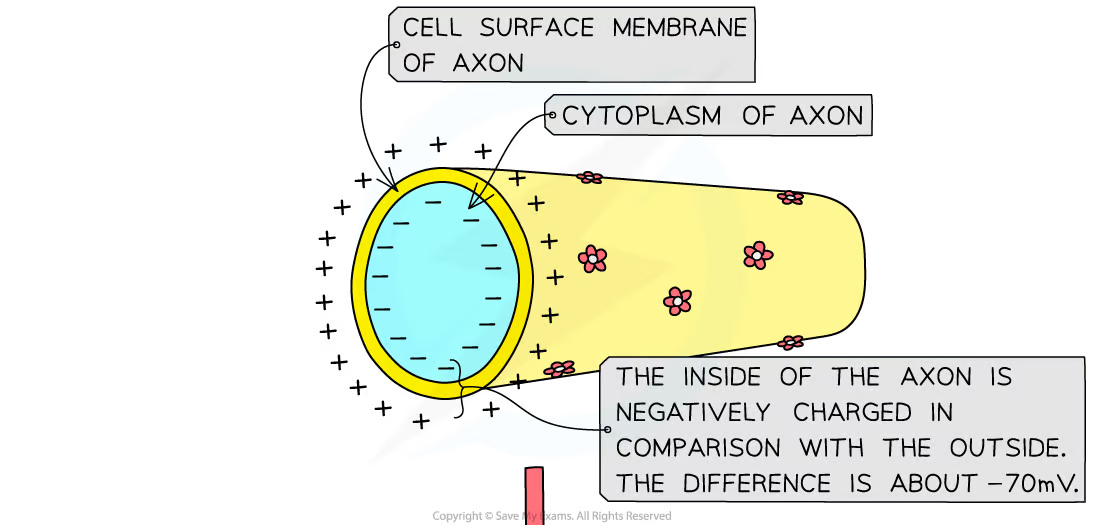
58
New cards
The neuron has to be ==polarised== to be -70mV, what does this mean?
That if **one side is positive,** the **other** must be **negative.**
59
New cards
What two components are used in the resting potential?
* Sodium Potassium Pump
* Potassium Gated Ion Channel
* Potassium Gated Ion Channel
60
New cards
What is the role of the sodium potassium pump?
proteins in the cell membrane that **maintain diffusion gradients** for K+ and Na+ **across the membrane**
61
New cards
What type of transport does the sodium potassium pump use? What does it need?
**Active transport,** **ATP** is needed, lots of **mitochondria**
\
*therefore this involves hydrolysis of ATP into ADP +Pi*
\
*therefore this involves hydrolysis of ATP into ADP +Pi*
62
New cards
What are features of the potassium gated ion channel?
* specific to **K+**
* Mainly **open** and there **are more of these** than Na/K+ pump therefore **membrane is more permeable to potassium.**
* Diffuses K+ **faster**.
* Mainly **open** and there **are more of these** than Na/K+ pump therefore **membrane is more permeable to potassium.**
* Diffuses K+ **faster**.
63
New cards
what two forces are involved in the movement of K+ ions through the K+ channel? what is this force called?
==ELECTROCHEMICAL==
1. __*concentration gradient*__
**How much more K+** there is on the **outside or inside compared to Na+**.
2. __*electrical gradient*__
Is the **charge more positive on the outside or the inside**? the **difference in charges** that drives the movement of K+
1. __*concentration gradient*__
**How much more K+** there is on the **outside or inside compared to Na+**.
2. __*electrical gradient*__
Is the **charge more positive on the outside or the inside**? the **difference in charges** that drives the movement of K+
64
New cards
Explain the process of resting potential *add picture*
* **Low Na+ and High K+** on the **outside** compared to inside.
* **Sodium Potassium pump** combats this by using **active transport and ATP** to transport **3 Na+** to the **outside** and **2 K+** to the **inside**.
* This **creates potential difference** (more negative as there’s 2 K+ instead of equally 3) and **high concentration of K+** in the **inside**
* High concentration gradient of 2 K+ is on the inside therefore they **go through the potassium channel outside to even this out.**
* Eventually **less 2 K+ inside** so it **goes back down** (through **facilitated diffusion**)
* **Continuous movement of K+** as it reaches **equilibrium/electrochemical gradient of -70mV**
* Ending with **high K+ and low Na+** on the **inside** compared to the outside.
* **Sodium Potassium pump** combats this by using **active transport and ATP** to transport **3 Na+** to the **outside** and **2 K+** to the **inside**.
* This **creates potential difference** (more negative as there’s 2 K+ instead of equally 3) and **high concentration of K+** in the **inside**
* High concentration gradient of 2 K+ is on the inside therefore they **go through the potassium channel outside to even this out.**
* Eventually **less 2 K+ inside** so it **goes back down** (through **facilitated diffusion**)
* **Continuous movement of K+** as it reaches **equilibrium/electrochemical gradient of -70mV**
* Ending with **high K+ and low Na+** on the **inside** compared to the outside.
65
New cards
Why at the end of resting potential, the potential -70mV?
* Outside=positive, Inside=negative
* **always higher Na+ at the outside** as there’s **no channel** for that to move around like K+
* There is **no Net movement** (one moves, the other moves)
* **always higher Na+ at the outside** as there’s **no channel** for that to move around like K+
* There is **no Net movement** (one moves, the other moves)
66
New cards
Why are proteins needed for the resting potential?
membrane is **not permeable** enough
67
New cards
what is an ==action potential==?
a large **change in the voltage** across the **membrane**
68
New cards
what happens when a stimulus (changing environment) is received by a receptor?
causes **temporary reversal** of charges - **depolarisation**
axon membrane goes from **-70mV to +40mV**
axon membrane goes from **-70mV to +40mV**
69
New cards
what is the definition of ==depolarisation==
**loss of difference of charges** between inside and outside of axon membrane due to **change in permeability and sodium**
70
New cards
what are the three steps of action potential?
stimulus
depolarisation
repolarisation
depolarisation
repolarisation
71
New cards
Action potential/ depolarisation described (5)
1. threshold reached due to **stimulus/increase pearmeability**
\
2. **threshold of -55mV** causes **voltage dependent sodium channels** to **open** (norm closed in resting potential)
\
3. diffusion of **sodium (Na+) by facilitated diffusion into** the **axon** along **electrochemical gradient** - *they are + and therefore diffuse into the - axon, there are also more k+ inside*
\
4. this diffusion of na+ triggers **reversal of potential difference** so becomes **less negative inside +40mV**
\
5. action potential is **established**
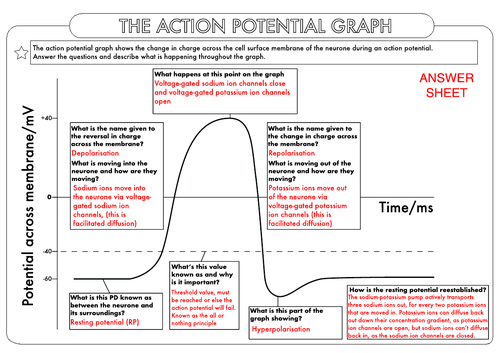
72
New cards
Action potential/ repolarisation described (3)
1. action potential established at +40mV causes **na+ channels to CLOSE**
2. voltage dependent **k+ channels open**, and many more continue to open **due to electrical gradient** - *too positive inside the axon*
3. causes **repolarisation reducing charge** and making axon **inside more negative**
\
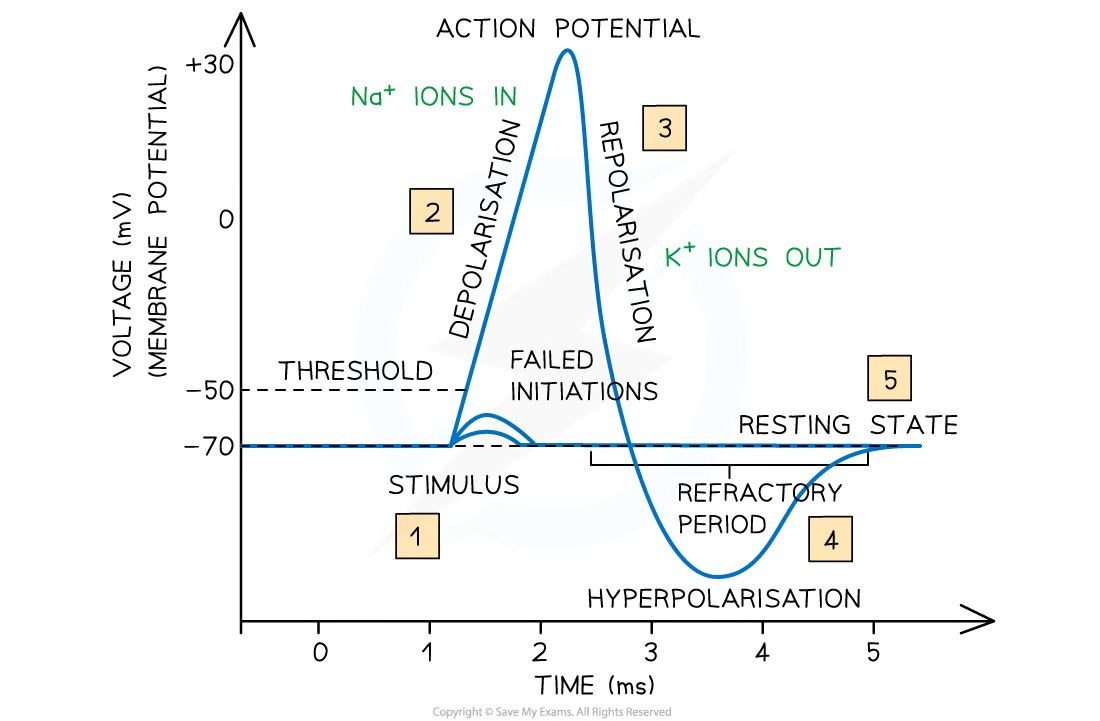
73
New cards
Action potential/ hyperpolarisation (6)
1. repolarisation does too much and causes **overshoot of electrochemical gradient**
2. becomes **highly negative** due to many **k+ diffusing out**
3. this state reached **-90mV** (hyperpolarisation)
4. **k+ channels** now **close**
5. **sodium/potassium pump restores**
6. resting potential re-established
\
\
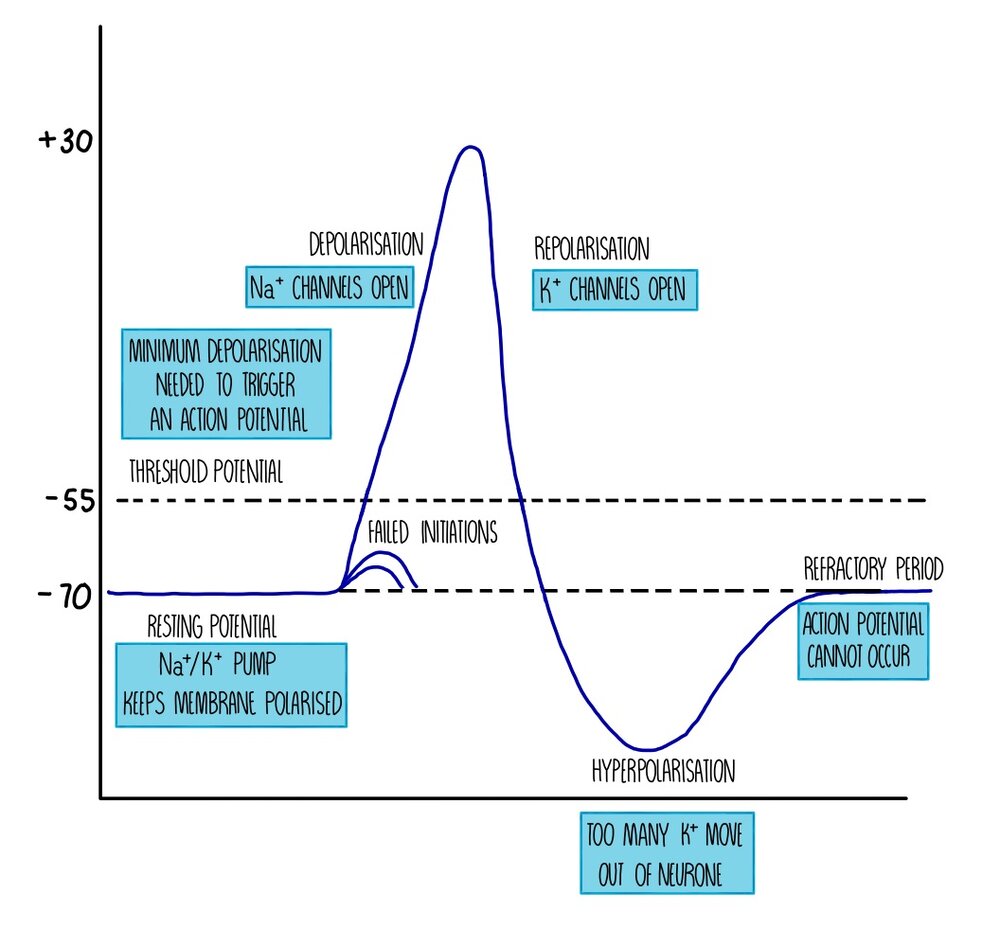
74
New cards
what is the ==refractory period==?
where the nerves are **unable to generate any new action potentials**
\
\
75
New cards
why is the refractory period important?
* **limits** number of impulse transmissions to **prevent over reaction and overwhelmed**
* ac travels in **one direction** \*
* ac travels in **one direction** \*
76
New cards
what is a ==threshold==? what does it do?
**-55mV**
* if not reached/surpassed, there will be **no ac (all or nothing)**
* **prevents** use from overreacting or getting action potential **when not needed** (not always in active state)
* if not reached/surpassed, there will be **no ac (all or nothing)**
* **prevents** use from overreacting or getting action potential **when not needed** (not always in active state)
77
New cards
what are 4 factors that affect the propagation of action potential?
* absence of myelin
* presence of myelin
* diameter
* temperature
* presence of myelin
* diameter
* temperature
78
New cards
absence of myelin (3)
* found in **short neurones**
* as waves move down, **earlier parts start to depolarise**
* happens **all the way down towards the terinal end**
\
(axon is in **refractory**)
* as waves move down, **earlier parts start to depolarise**
* happens **all the way down towards the terinal end**
\
(axon is in **refractory**)
79
New cards
presence of myelin (5)
* found in **longer neurones**
* **increases** transmission through **saltatory conduction**
* **nodes of ranvier** are gaps where **depolarisation** only **occurs**
* one node has **ions flowing**, causes **reduction of potential difference in next** node
* action potential **jumps** from one node to another
* **increases** transmission through **saltatory conduction**
* **nodes of ranvier** are gaps where **depolarisation** only **occurs**
* one node has **ions flowing**, causes **reduction of potential difference in next** node
* action potential **jumps** from one node to another
80
New cards
why is myelinated axon more effective
* **saltatory conduction** (jumps from one node to another)
* **energy efficient** as it uses less ATP for sodium potassium pump
* **energy efficient** as it uses less ATP for sodium potassium pump
81
New cards
diameter on propagation of action potential
bigger axon diameter - **faster impulse**
*due to* ***less resistance***
*due to* ***less resistance***
82
New cards
temperature on propagation of action potential
higher temp - **ions diffuse faster**
*if temp to high it can* ***denature carrier proteins***
*if temp to high it can* ***denature carrier proteins***
83
New cards
what is a ==synapse==?
where neurons **communicate with one another** using **neurotransmitters** at junctions
84
New cards
what are two different types of neurotransmitters and their purpose?
**excitatory** - causes postsynaptic to **depolarise** /action potential *triggered*
\
**inhibitory** - causes postsynaptic to **hyperpolarise** /action potential *not triggered*
\
**inhibitory** - causes postsynaptic to **hyperpolarise** /action potential *not triggered*
85
New cards
what are the six parts of the synapse area
* synaptic cleft
* presynaptic
* postsynaptic
* synaptic knob
* neurotransmitters receptors
* synaptic vesicles
* presynaptic
* postsynaptic
* synaptic knob
* neurotransmitters receptors
* synaptic vesicles
86
New cards
==synaptic cleft==
**intercellular space** between **axon terminal** and **dendrite** that **contains enzymes** that break down neurotransmitters
87
New cards
==presynaptic neurone==
where the **action potential has come from** (the og)
88
New cards
==post synaptic neurone==
where the **action potential/impulse is recieved**
89
New cards
==synaptic knob==
**swollen end** of axon that **contains mitochondria** and **SER** to **synthesise** neurotransmitters and **make vesicles** (20-30nm)
90
New cards
==synaptic vesicle/neurotransmitter receptor==
**receptor molecule** which neurotransmitter **binds to** in postsynaptic membrane
91
New cards
the process of synaptic transmission of any cell (6) \*picture needed
1. **incoming action potential** causes **depolarisation of knob**
2. this causes **voltage dependent calcium channel to open** allowing **ca2+** to diffuse into through electrochemical gradient
3. this causes **synaptic vesicles to fuse with presynaptic membrane**
4. neurotransmitter **released by exocytosis into the synaptic cleft**
5. neurotransmitter **binds to receptor on sodium ion channels** causing it to **open and release na+** in (action potential begins) this only **happens when threshold is reached**
6. neurotransmitter **taken up across presynaptic membrane** and **closes sodium channels** preventing more and new action potentials
92
New cards
what is a cholinergic synapse?
containing **acetylcholine**
93
New cards
how is acetylcholine recycled?
* **acetylcholinerase** **hydrolyses** into choline and acetate
* these **diffuse back into presynaptic bulb**
* these **diffuse back into presynaptic bulb**
94
New cards
what is the ATP from the mitochondria and the SER in the presynaptic knob used for?
ATP - **recombine** acetate and choline
SER - **make** acetylcholine
\
*vesicles store this for future*
SER - **make** acetylcholine
\
*vesicles store this for future*
95
New cards
why is it important for the acetylcholine to be broken down and taken across presynaptic bub
otherwise **channels will stay open** -continuous action potential
96
New cards
another term to use for presynaptic and postsynaptic neuron
pre synaptic - sensory
post synaptic - relay
post synaptic - relay
97
New cards
what are the three roles of the synapse?
* control of nerve pathways, allowing flexible response
* integration of info from diff neurons for coordination
* ensure impulse go in one direction
* integration of info from diff neurons for coordination
* ensure impulse go in one direction
98
New cards
what two main factors affect the likelihood that the post synaptic membrane will depolarise?
* type of synapse
* number of impulses received
* number of impulses received
99
New cards
how does the excitatory synapse accept neurotransmitters?
(same steps as depolarisation)
* cell undergoes small amount of depolarisation but not enough to cause an action potential
* cell undergoes small amount of depolarisation but not enough to cause an action potential
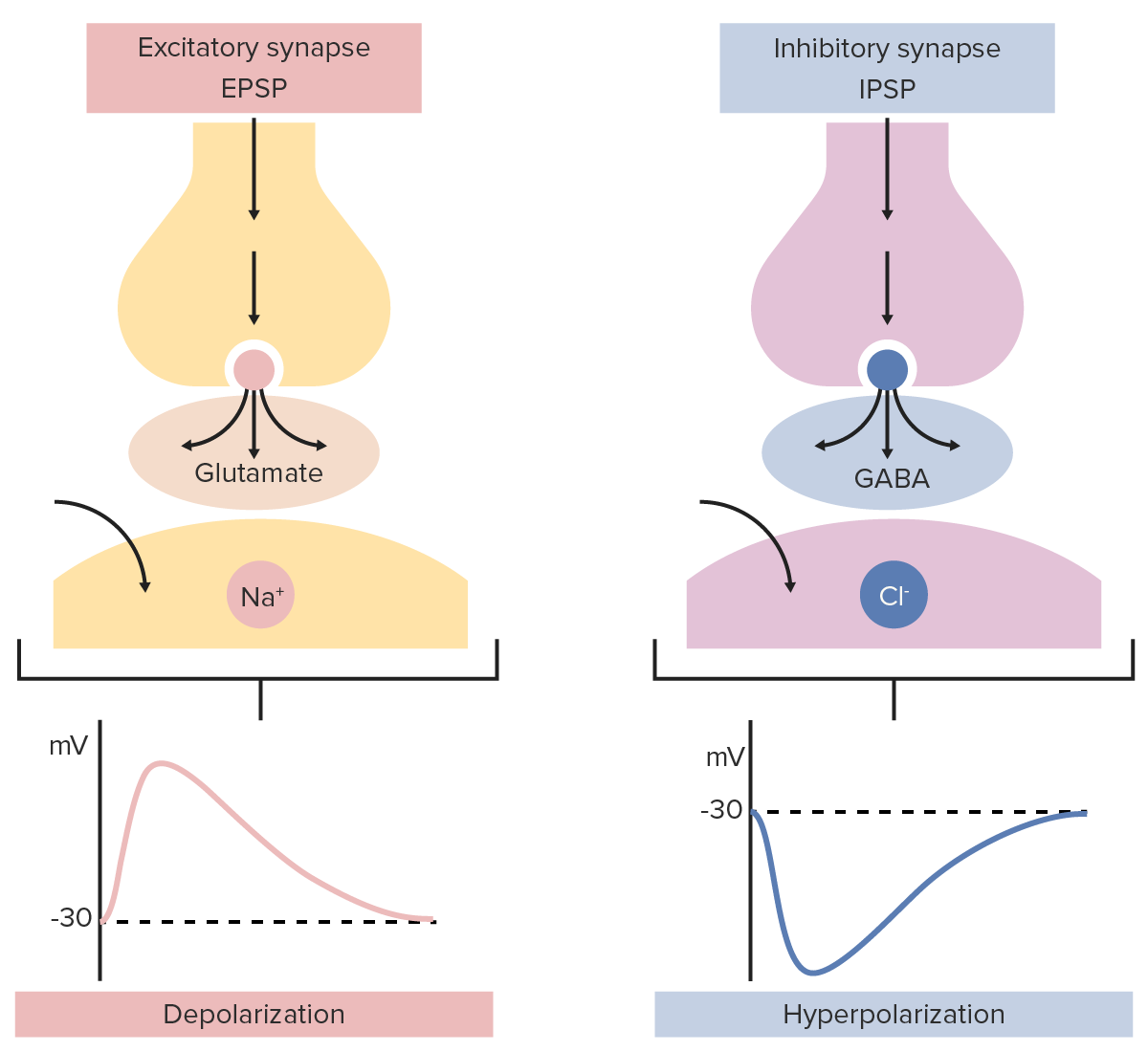
100
New cards
how does the inhibitory synapse accept neurotransmitters? (4)
* causes hyperpolarisation
* synapse opens chloride and potassium channels
* chloride in and potassium out
* greater potential difference
* synapse opens chloride and potassium channels
* chloride in and potassium out
* greater potential difference
